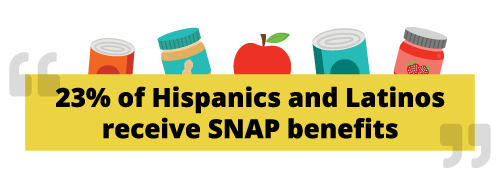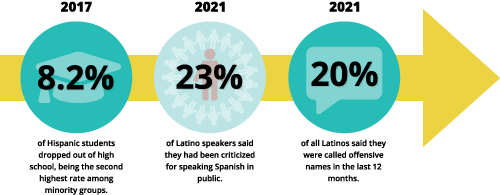The United States of America is considered the melting pot of the world, filled with people of all different religions, races, ethnicities, countries, and backgrounds.
While we are lucky to live in a nation filled with such a rich and diverse population, it is clear that everyone has a different experience - especially those who are part of a marginalized group or community. Minority groups in America often struggle when it comes to receiving equal treatment, creating obstacles in their day-to-day life.
Latinos/as are no exception, and this group faces the large hurdle of food insecurity on a daily basis.
Note: For the purpose of this blog, the term Latinx is used to describe a person of Latin American origin or descent. The Move For Hunger team has chosen to use this term as a way to be more inclusive of anyone originating from Latin America.
Hispanic and Latino/a Americans have been the largest ethnic minority since 2003 in the United States
Since the year 2000, the Latinx population in the United States has doubled and is expected to continue to grow. There are more than 62 million Latinos in the United States, making up about 19% of the entire population. Higher rates of food insecurity in the Latinx community are a direct effect of racial discrimination, and on average, the median income of Latino households is $20,000 less than the median income of white households.
Besides facing lower income, Latinos face significantly higher rates of unemployment, making it hard to provide both a roof over their head and the daily food that they need.

Latinx communities experience hunger at a higher rate
Racial prejudice, language, education, and cultural barriers create inequalities that make Latinx communities more impacted by food insecurity. In 2021, Latinos were 2.5 times more likely to experience food insecurity than majority communities , and 18.5% of Latinos experienced food insecurity. This means that 1 in 6 Hispanic individuals in the United States are food insecure. Latino children are also more than twice as likely to face hunger as white children.

For many Latinos, the Supplemental Nutrition Assistance Program (SNAP) has helped keep food on the table. About 23%, or five million, of SNAP recipients have a Hispanic head of household, according to the Center on Budget and Policy Priorities. There are many barriers for Latinx families when it comes to applying for food assistance programs, including language differences, transportation issues, or simply not being aware of the programs available.
However, there are significant barriers that prevent eligible Latinos from enrolling in federal food assistance programs. The USDA shows that more than 4 million Latinos are eligible yet remain unenrolled in SNAP.
Limited resources to conduct outreach, lack of awareness of eligibility requirements, and limited information in the Spanish-language about federal nutrition programs keep many eligible families from being able to access healthy food.
While SNAP has helped struggling Latinx communities live more comfortably, there is still plenty of work that needs to be done to ensure people of all backgrounds can live without the stress of worrying about where their next meal will come from.
Latinos are more likely to lack access to healthy food
According to Bread for the World, Latino children are nearly twice as likely to lack access to sufficient nutritious food as non-Latino white children. This is due to a multitude of reasons including limited access to transportation, being paid subminimum wages, and working longer hours to make ends meet. More than three-quarters of the wage gap is attributable to their relative youth, English language deficiencies, and their lower educational attainment. However, these variables explain less than a third of the wage gap.
Less income to purchase nutritious foods and essential health care contribute to higher rates of serious medical problems among Latinos, including cancer, obesity, and diabetes.

Latinx Communities face higher levels of school dropouts, therefore struggling to receive a steady income.
High rates of food insecurity amongst Latinos are not only caused by discrimination in the job market. Many lower-resourced schools throughout the country are located in Latinx communities, leading to higher levels of dropouts.
66% of Latinos who immediately entered the workforce or military without going to college stated that they did so to help support their families. Without higher education, finding a job that provides a steady income to live on becomes much harder, but this is not an option for many young Latinos. This all goes to show that many institutional deficiencies lead to hunger within the Latinx community.

Recent political topics create more barriers for Latinx communities
The recent political climate has led to racial, ethnic, and anti-immigrant prejudice, including discrimination in employment, housing, and education. Acts of violence and hate crimes have also caused injuries and deaths among Hispanic/Latino people in the United States with one of the most notable recently being the mass shooting in El Paso, Texas in 2019 where Latinos were targeted in a Walmart Store by a gunman. Twenty-three people were killed and 22 others were injured. Authorities said that the gunman posted hate-filled statements condemning the “invasion” of Mexican immigrants in the United States.
According to the Biden administration, President Biden is working to ensure that all Latino families and communities can live with dignity, respect, and greater economic opportunity. Biden has signed into law two pieces of legislation that are claimed to create greater opportunity for Latino families - The inflation Reduction Act, and the Bipartisan Infrastructure Law.
The Inflation Reduction Act lowered prescription drug costs, health care costs, and energy costs. By lowering the costs of other necessary payments, it is easier for families to afford groceries. Roughly 30% of Hispanics in the US lack health coverage.
The Bipartisan Infrastructure Law was created to support federal public transportation programs. According to the Pew Research Center, 27% of Hispanics report taking public transit weekly, or daily, compared to only 11% of the overall population. By ensuring reliable transportation in the United States, this can help lower transportation costs and increase the ability for Latinx communities to find work.
Mass incarceration and deportation deplete resources in the Latinx community
Soaring incarceration rates from over-policing and immigrant raids split families and deplete resources. The court costs place a burden on already struggling families since they must borrow money and/or have less money for basic living expenses. The family of someone in prison owes an average of $13,000 in court fees, and someone detained by immigration officials must pay up to $10,000 in bonds to get the person released, according to Bread for the World.
The National Library of Medicine reports that Latino males currently have a higher representation among young adult male prisoners than any other ethnic group. After being exposed to high-risk environments in correctional facilities, formerly incarcerated Latino men encounter new risks upon reentering their community of residence including drug use. The re-entry process into one’s community has been found to be stressful and associated with overall high risk-taking behaviors.
Discrimination in the workplace

Latino American discrimination is not a new issue - it actually dates back to the 19th century when political events in Mexico made emigration to the United States popular. Amid a tanking economy in the U.S., Anti-Latino sentiment grew - along with immigration. Anglo-Americans treated them as a foreign underclass and perpetuated stereotypes that those who spoke Spanish were lazy, stupid, and undeserving.
For example, in the 19th century Anglo-Americans often referred to immigrants from Mexico as “greasers”. According to this article by Duke University, “a ‘greaser’ was a Mexican—originating in the filthy, greasy appearance of the natives”. Immigrants were considered “indolent, nonprogressive and, on the whole, culturally inferior” and, as a result of this viewpoint, immigrants were forced to suffer through murders, mutilations, and lynchings by Anglo-Americans.
Even today, the immigration debate has continued to fuel anti-Latino sentiments, with many Latinos being unfairly targeted due to their perceived immigration status. Socioeconomic disparities and limited access to quality education and healthcare also contribute to their marginalization. While progress has been made in addressing these issues, the ongoing challenges faced by Latinos highlight the need for continued efforts to combat discrimination and promote inclusivity in the United States.
Ways to Take Action
The plight of food insecurity within the Latinx community in the United States is a deeply rooted and multifaceted issue. From economic disparities and employment discrimination to educational challenges and immigration-related fears, the Latinx community's struggle with food insecurity is a reflection of systemic inequalities that persist in our society.

The fight against food insecurity within the Latinx community is part of a broader movement to combat hunger and food waste, not only among Latinx individuals but also among other marginalized communities. By taking action, supporting initiatives, and advocating for change, we can make strides toward a more equitable and just society where everyone has access to the nourishment they need to thrive.
Check out other communities impacted by food insecurity, such as the LGBTQ+ community, Native American communities, and women, or learn about hunger and food waste.
To join the effort in fighting against food insecurity, consider ways to take action by clicking here.
